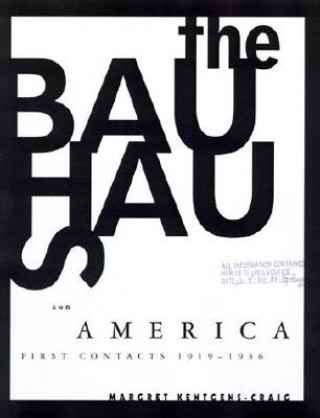
Code: 04562465
Bauhaus and America
by Margret Kentgens-Craig
The Bauhaus school was founded in Weimar in 1919 by the German architect Walter Gropius, moved to Dessau in 1925 and to Berlin in 1932, and was dissolved in 1933 by Ludwig Mies van der Rohe under political duress. Although it exis ... more
- Language:
 English
English - Binding: Paperback
- Number of pages: 288
Publisher: MIT Press Ltd, 2001
- More about this

32.64 €
RRP: 39.38 €
You save 6.75 €
Availability:
50/50 We think title might be available. Upon your order we will do our best to get it within 6 weeks.
We think title might be available. Upon your order we will do our best to get it within 6 weeks.We search the world
You might also like
-

Church Dogmatics
266.94 € -

Emperor of Japan
125.33 € -

Triceratops
10.20 € -

Elsevier's Dictionary of Nuclear Engineering
291.10 € -

Ancient Egypt in the Metropolitan Museum Journal
43.05 € -

Friends Along the Way
94.60 € -

Foucault, Psychology and the Analytics of Power
143.12 €
Give this book as a present today
- Order book and choose Gift Order.
- We will send you book gift voucher at once. You can give it out to anyone.
- Book will be send to donee, nothing more to care about.
Availability alert
Enter your e-mail address and once book will be available,
we will send you a message. It's that simple.
More about Bauhaus and America
You get 82 loyalty points
 Book synopsis
Book synopsis
The Bauhaus school was founded in Weimar in 1919 by the German architect Walter Gropius, moved to Dessau in 1925 and to Berlin in 1932, and was dissolved in 1933 by Ludwig Mies van der Rohe under political duress. Although it existed for a mere fourteen years and boasted fewer than 1,300 students, its influence is felt throughout the world in numerous buildings, artworks, objects, concepts, and curricula.After the Bauhaus's closing in 1933, many of its protagonists moved to the United States, where their acceptance had to be cultivated. The key to understanding the American reception of the Bauhaus is to be found not in the migr success stories or the famous 1938 Bauhaus exhibition at the Museum of Modern Art, but in the course of America's early contact with the Bauhaus. In this book Margret Kentgens-Craig shows that the fame of the Bauhaus in America was the result not only of the inherent qualities of its concepts and products, but also of a unique congruence of cultural supply and demand, of a consistent flow of information, and of fine-tuned marketing. Thus the history of the American reception of the Bauhaus in the 1920s and 1930s foreshadows the patterns of fame-making that became typical of the post-World War II art world. The transfer of artistic, intellectual, and pedagogical concepts from one cultural context to another is a process of transformation and integration. In presenting a case study of this process, the book also provides fresh insights into the German-American cultural history of the period from 1919 to 1936.
 Book details
Book details
Book category Books in English The arts History of art / art & design styles History of art & design styles: from c 1900 -
32.64 €
- Full title: Bauhaus and America
- Subtitle: First Contacts, 1919-1936
- Author: Margret Kentgens-Craig
- Language:
 English
English - Binding: Paperback
- Number of pages: 288
- EAN: 9780262611718
- ID: 04562465
- Publisher: MIT Press Ltd
- Weight: 584 g
- Dimensions: 177 × 226 × 23 mm
- Date of publishing: 23. February 2001
Trending among others
-

Bloodborne Official Artworks
36.88 € -18 % -

Dark Souls: Design Works
33.35 € -17 % -

Monster Hunter Illustrations
37.89 € -17 % -

Bauhaus
13.74 € -10 % -

Hilma af Klint
54.27 € -16 % -

Hopper Drawings
7.47 € -19 % -

Remedios Varo
36.88 € -19 % -

The Art of Horizon Zero Dawn
32.23 € -15 % -

Principles of Creature Design
37.29 € -22 % -

American Art Deco
63.77 € -5 % -

Klee
15.35 € -28 % -

Pop Manga Mermaids and Other Sea Creatures
14.34 € -17 % -

The Andy Warhol Diaries
17.48 € -19 % -

Hi-Fructose: New Contemporary Fashion
40.12 € -18 % -

True to Life
27.99 € -4 % -

Book from the Ground
13.13 € -11 % -

Dark Souls II: Design Works
37.19 € -26 % -

The Legend of Zelda: Hyrule Historia
36.98 € -9 % -

Palette Perfect
22.33 € -20 % -

Behold!!! The Protong
29.30 € -28 % -

Dali. The Paintings
20.41 € -

Yorkshire Sketchbook
16.97 € -20 % -

Final Fantasy Ultimania Archive Volume 1
35.06 € -13 % -

Cats Galore
21.01 € -18 % -

Grapefruit
20.51 € -21 % -

Monster Hunter Illustrations 2
46.08 € -16 % -

Pop Art
13.84 € -9 % -

Beauty of Kinbaku
38.40 € -5 % -

Art Since 1900
62.25 € -22 % -

Andrew Wyeth
56.59 € -4 % -

Dior: The Legendary Images
42.04 € -16 % -

Edward Hopper
11.41 € -27 % -

Kay Nielsen. East of the Sun and West of the Moon
16.16 € -23 % -

Botanicals
18.59 € -8 % -

Art Deco Complete
60.74 € -27 % -

Hammershoi and Europe
30.01 € -26 % -

de Lempicka
16.97 € -19 % -

Berlin in the 1920s
14.85 € -2 % -

Munch
15.56 € -

Net of Being
42.65 € -15 % -

Abstract Expressionism
15.35 € -9 % -

O'Keeffe
15.35 € -9 % -

Disrupted Realism: Paintings for a Distracted World
42.54 € -15 % -

Egon Schiele
15.45 € -26 % -

Cy Twombly
45.17 € -8 % -

Ensor
16.06 € -23 % -

ANNI ALBERS
30.21 € -28 % -

Jazz
23.24 € -17 % -

Faerie Handbook
28.19 € -17 %
Collection points Bratislava a 2642 dalších
Copyright ©2008-24 najlacnejsie-knihy.sk All rights reservedPrivacyCookies


 15549 collection points
15549 collection points Delivery 2.99 €
Delivery 2.99 € 02/210 210 99 (8-15.30h)
02/210 210 99 (8-15.30h)